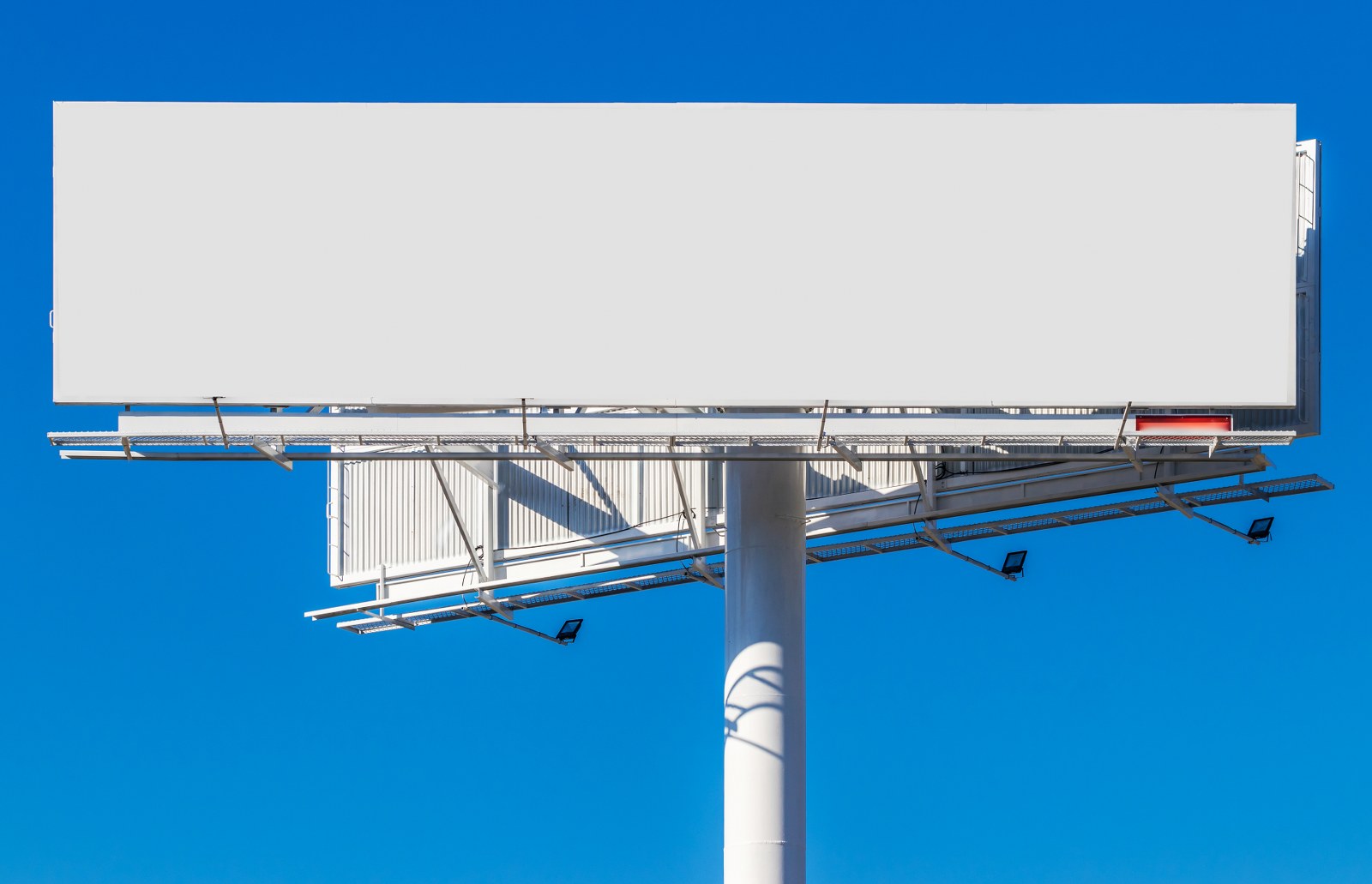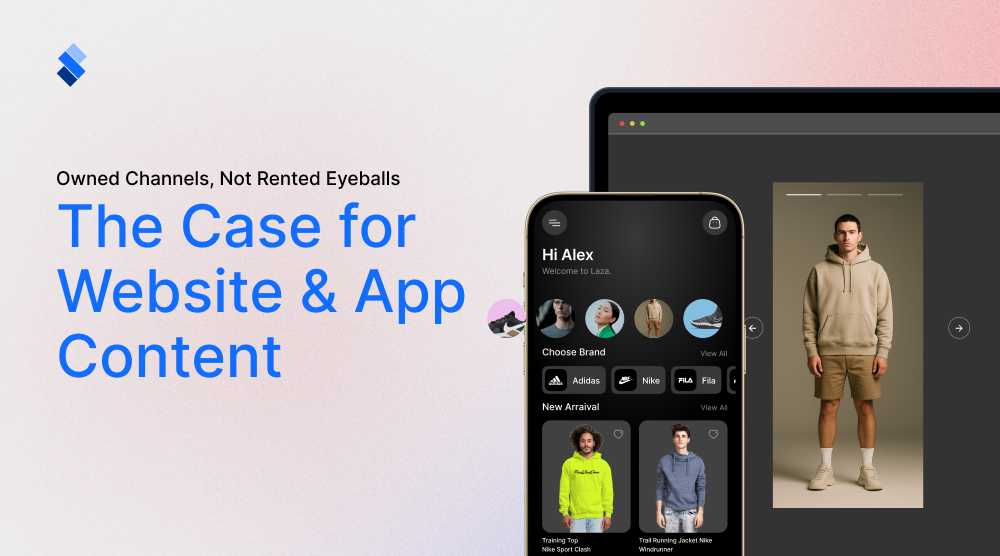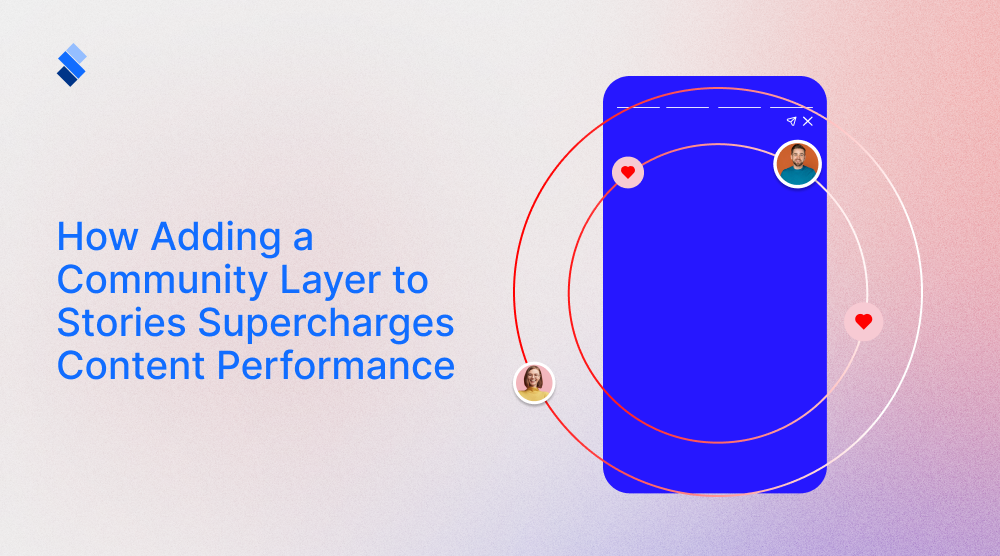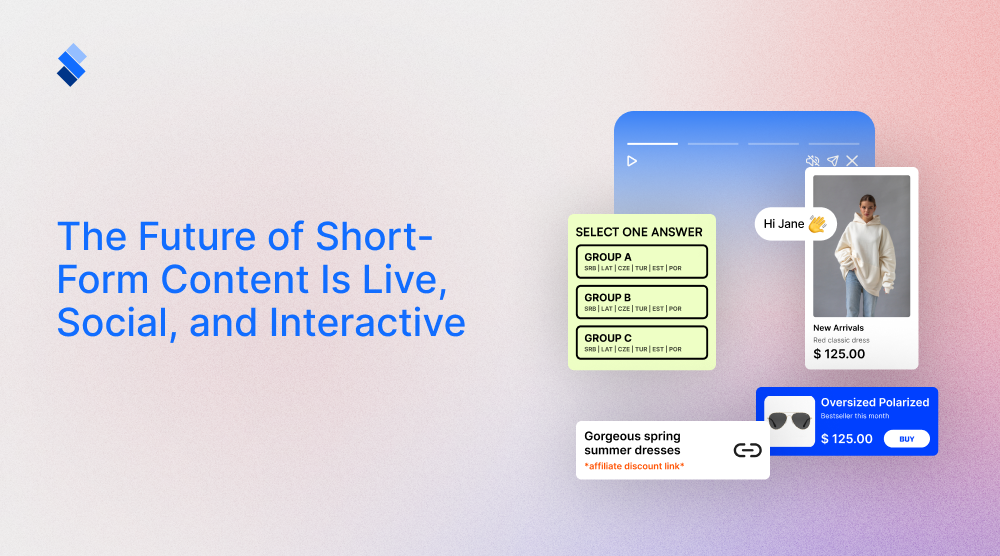From Passive Content to Actionable Stories: How Brands Turn Viewers Into Buyers
To engage modern viewers, modern marketers must shift from passive content to actionable stories. This is no longer a matter of choice, but a matter of survival.

There are a few things in modern marketing that are as effective as an actionable story. Whether it is in-app, native, or on social media, a good story will not only grab the viewer's attention but also turn them into a buyer. So, you can imagine our surprise when we still see brands insisting on using passive, static content. To help correct this, we will delve deeper into the differences between static content and actionable stories and outline how you can use your stories as full-fledged sales funnels.
Passive content - the end of an era
Not so long ago, passive content was all there was when it came to online marketing. Blog posts, static images, premade videos... Those were the available options. Those brands that understood their audience knew how to create passive content that would garner interest, which naturally led to success. Knowing this required ample third-party customer data, along with some hands-on customer research. The more curated the content, the better the odds that it will grab the viewer's interest and have them check out what you have to say.

Well, we are in the twilight of the static marketing content. While there is still decent passive content out there, more and more brands are turning towards interactive content. And with good reason. With a bit of research, we've found out that:
- Interactive content generates 52.6% more engagement than static content.
- Users spend an average of 53% longer on interactive content than on static content.
- Interactive content converts at 2 - 3x higher rates than passive content.
- Interactive content improves information retention by 68% compared to passive content.
- Personalized interactive experiences (e.g., quizzes, polls) increase brand recall by 40%.
Therefore, it is easy to see why we see passive content as outdated. There are further stats that help illustrate this point, but the bottom line is that passive content isn't enough for modern audiences. Sure, static content still has a role to play in marketing. And it will likely always have a role. But if you wish to yield results, your content needs to grab the viewer by the collar and give them a reason to act. In this regard, interactive content is invaluable. And one of the often overlooked types of interactive content is actionable stories.
Why is interactivity important?
There are two factors that played into the actionable content's favour and made it so effective in viewer engagement. Firstly, because we've been exposed to marketing content for so long, we've become somewhat tired of it. Ad fatigue and habituation are established phenomena in modern online viewership, where most viewers are either annoyed or simply ignore static marketing content. Secondly, actionable content, due to its interactive elements, makes itself distinct from passive content, thus avoiding fatigue and habituation. There are certain psychological elements in play that make actionable content that much more alluring.

For instance, we have the Endowment effect. It states that people value things more when they feel personal ownership. Well, once we interact with something, we feel much closer to it than we would with something that we passively view. This is further enhanced by the fact that when users take action (e.g., answering a quiz), they subconsciously justify their effort by valuing the content more (a form of effort justification). Meanwhile, static content doesn’t require effort, leading to weaker memory encoding. Arguably, the most important factor is that actionable content leaves a lot of room for personalisation. Customized feedback from content (e.g., "The best destination for your personality type is…") makes it feel more relevant, increasing emotional connection. The biggest problem with passive content is the one-size-fits-all mentality, which reduces personal attachment.
An actionable story as a sales funnel
Actinable stories can be used to simply garner user interest and help promote your brand. And this is a perfectly fine use that you can use to both build brand reputation and improve communication with your customers. But another use of actionable stories is in turning viewers into shoppers. And in that case, actionable stories effectively turn into sales funnels.

A sales funnel is a marketing term describing the process of turning viewers into buyers. While there are many ways to outline a sales funnel, we feel that the most straightforward one consists of 4 parts. The hook, the engagement, the conversion push, and the retention play. Each segment of the funnel serves a different role in converting a viewer to a buyer. When created with ample forethought, an actionable story can contain all these parts and yield tremendous results (which we will outline later).
The Hook (Top of Funnel – TOFU)
The goal of the hook is to draw attention. This can be done in many ways, from bombastic openings to intriguing questions to lesser-known industry facts. What's important is that you understand your audience and ensure that the hook naturally leads to the rest of the funnel.
There are many different types of hooks available, depending on what the rest of the story will be. These can include:
- The "Burning Problem" Hook - Provides a solution for a problem that people face regularly. Example: "Still wasting 3 hours a week on washing dishes? What if you could cut that time in half?"
- The "Social Proof Bomb" Hook - Here, you essentially use herd mentality to validate your offer. Example: "1,200 people bought this in 48 hours—here’s why."
- The "Curiosity Gap" Hook - The idea is to withhold just enough information to force a swipe. Example: "The one skincare ingredient dermatologists won’t talk about."
- The "False Belief" Hook - You challenge a common assumption held by the audience. "‘Organic’ doesn’t mean healthy. Here’s what to buy instead."
These are just some of the essentially endless possibilities. Each can have an interactive element, but this is not vital at this point. The point is to grab the viewer's attention and prepare them for further engagement. The more you experiment, the better you will know which one best works with your content and your audience.
The Engagement (Middle of Funnel – MOFU)
This is where most brands drop the ball. Grabbing the viewer's attention is one thing, but having it lead to a meaningful engagement is completely another. Here, you need to provide a payoff for their attention. The payoff depends on the hook, but it usually needs to provide a sense of satisfaction. As we said, interactive elements lean heavily into psychological mechanisms, which makes these payoffs far more effective than they would be in static content. But, a wrong payoff and you not only risk losing a viewer, but also having them feel frustrated with your entire brand.

A good rule to abide by in this segment is that personalization is key. While you have the viewer's attention, you need to use dynamic messaging and carefully curated content to make users feel understood. A common mistake that brands make is that they start shoehorning in conversions at this point. Don't. Feel free to encourage micro-commitments such as learning more or giving a simple input. This exploits the Foot-in-the-Door Technique, priming users for bigger conversions.
Most importantly, you need to ensure a seamless handoff to conversion. The goal in this stage of the funnel is to keep the momentum of engagement and lead it to the purchase. You do this by balancing education, interactivity, and psychological nudges.
The Conversion Push (Bottom of Funnel – BOFU)
The goal here is to eliminate final barriers to purchase by leveraging urgency, exclusivity, and frictionless design. The beauty of actionable stories is that they can be shoppable. This means that you can simplify the checkout process by integrating easy checkout options, trusted payment methods, and one-click upsells. By using this, you reduce cognitive load, thus ensuring that viewers don't second-guess their decision.
Post-purchase, immediate gratification (e.g., "Your order is confirmed, here’s a VIP bonus!") reinforces the decision with dopamine-driven rewards. You can also use follow-up emails or DMs with user-generated content ("Join others who love this!") to strengthen social proof, ensuring the transition from conversion to retention is seamless and psychologically sticky.
The Retention Play (Post-Purchase)
The final stage of the funnel serves to solidify brand loyalty and encourage repeat engagement. You do this by delivering immediate value through personalized thank-you pages, exclusive post-purchase bonuses, or VIP access to members-only content. The idea is to leverage the endowment effect by making customers feel like insiders.

One option is to use gamified loyalty programs with progress trackers ("You’re 200 points away from your next reward!"). This taps into goal-gradient theory (a psychological principle that explains how people become more motivated to complete a task or reach a goal as they get closer to achieving it). Another option is to encourage user-generated content (e.g., "Share your results for a feature!"). Doing so not only benefits your brand from exposure but also exploits social validation to turn buyers into brand ambassadors.
Examples
To make things clearer, we will take the hook examples we've outlined before and show what the rest of the funnel would look like with them. Keep in mind that these are just some of many ways in which you can orient your actionable story and ensure that it has decent conversion rates.
Hook: Burning Problem
Let's say that the first page in your actionable story stated: "Still wasting 3 hours a week on washing dishes? What if you could cut that time in half?" You've created a burning problem that the viewer can sympathize with and would like to know the solution to. So, what would be the next steps?
Middle
The middle part is when you can introduce interactivity. You can do so in the beginning, but it is best to first hook them, then have them interact with your content. In this specific instance, a "Time-Saving Calculator" can be a neat idea. Here, users would input their weekly dishwashing time and see how much they’d save with your product.
By doing so, users feel empowered as they can play around and customize the outcome. But, as an aftereffect, they’ve acknowledged the problem that washing dishes presents. Now they need the solution.
Conversion
The conversion is when you introduce the actual CTA. For instance, "Free up your time! See your customized plan" with a button or swipe that leads to a product demo or discount. This works as you've not only highlighted a product, but also provided an easy solution to it.
Retention
With retention, you need to look for what works within your target group. For an older audience, you might rely on a follow-up email, asking them to leave their impressions, or better yet, film a UGC. For a younger audience, you might want to lean into gamification. Example: "You’ve saved 5 hours this month! See where you stand compared to the rest of our users."
Hook: Social Proof Bomb
You've started your story with: "1,200 people bought this in 48 hours, here’s why." You've gained viewers' attention. What now?
Middle
On the next page, you showcase a "Why People Buy" quiz where people vote on why they purchased a specific product. (e.g., "Which of these 3 benefits matters most to you?"). By doing so, you not only show your product as popular, but you also help your viewer validate their reason for future purchase.
Conversion
Next, you would post a CTA: "Join the 1,200! Get yours before it’s gone," and you would post a swipe or a click to a limited-time offer. A viewer primed for purchase will now have extra motivation to buy, as their window for doing so is shortening.
Retention
For retention, you can either invite the customer to a VIP group (e.g., "You’re in! Meet other 1,200 smart buyers"). Or you can motivate them to create UGC. This further strengthens their resolve and makes your brand that much more important in their perception.
Hook: Curiosity Gap
You've sparked the user's curiosity with the hook: "The one skincare ingredient dermatologists won’t talk about." Now, flame that spark into a fire.
Middle
A "Reveal the Truth" scratch-off card where users digitally "scratch" to uncover the ingredient. A simple trick, but surprisingly effective. Instead of simply revealing the ingredient, you push your viewer to interact. This triggers anticipation and dopamine, as the scratch mechanic mimics gambling rewards. Furthermore, you've leaned into he pain of not knowing compels, which naturally compels action.
Conversion
Now you showcase the product that has the ingredient. "Get the full story!" page that leads to a product page on your website with the ingredient’s science. The trick here is that you've postponed the final reveal of both the ingredient details and the product that has it. The scratch interaction creates sunk cost bias, meaning that users who engage want to "finish" the story. By the end, they've already learned all that is necessary for a conversion.
Retention
For retention purposes, you can assume that your customers are interested in dermatology products. So, it only makes sense to showcase other stories featuring ingredients or even educational series like "5 More Secrets Dermatologists Hide".
Hook: False Belief
You shatter a false belief by stating, "Organic doesn’t mean healthy. Here’s what to buy instead." How to make use of this?
Middle
A neat interactive element you can introduce here would be a "Myth vs. Fact" swipeable carousel. A commonly held myth, that users swipe to reveal truths. It should come as little surprise that
People enjoy proving old beliefs wrong, which is the guiding psychological drive behind this approach.
Conversion
The feeling of joy for the sudden burst of knowledge is an ideal time for a CTA. For instance, "Get the real healthy shopping list". This can lead to an interactive list where users can pick products from your website (with personalised recommendations from your brand).
Retention
For retention, you can either post a challenge where you test your users' shopping knowledge in shopping for healthy products: "Are you a healthy shopper? Try your skill by shopping without our assistance!" By providing a ranking system, you can give your customers a sense of accomplishment when shopping with your brand.
Final thoughts
The actionable stories we've provided should give you a good enough idea of how to start creating your own. As you can see, the main thing is to understand the viewer's journey through your story and what elements would aid in conversion. There is little room for content here, so you need to avoid useless or filler elements. Everything within the story should serve some purpose. If you feel like giving it a go, StorifyMe is here to help every step of the way. The sooner you start using actionable stories, the sooner you will improve your conversion rates.







